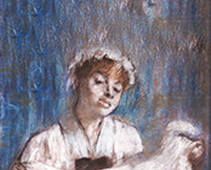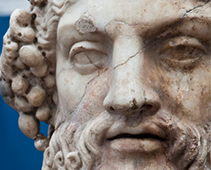Period:
400 BC.
GODDESS OF THE UNDERWORLD, OR A DECEASED WOMAN?
For the Etruscans the tomb was a person's dwelling in the afterlife.
Etruscan sculpture is often linked to tombs. This may be in the ornamentation of sarcophagi, cinerary urns and grave markers. One astonishing example is the beautiful stone sculpture in the Ancient Mediterranean Collection representing a woman seated on a chair, each arm of which is in the form of a sphinx. The sculpture is hollow and the head is detachable. It may represent either a deceased woman or one of the goddesses of the underworld. The craftsmanship is of a high order which may indicate that the figure was the work of a Greek sculptor in Etruria around the middle of the 5th century BC. Today it appears in the light hue of the stone, but in Antiquity it may have been painted in striking colours.




